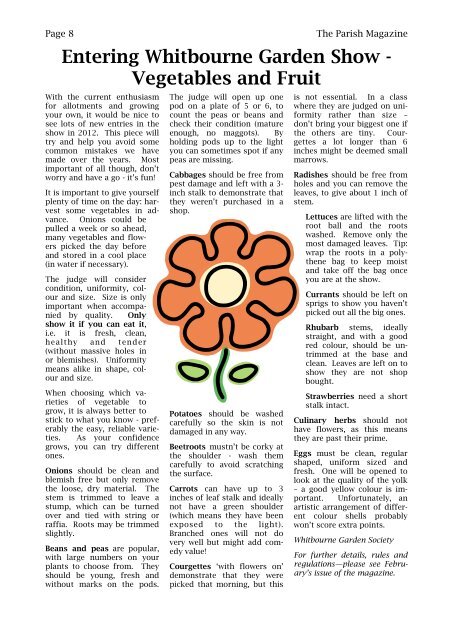click - Parish of Greater Whitbourne
click - Parish of Greater Whitbourne
click - Parish of Greater Whitbourne
You also want an ePaper? Increase the reach of your titles
YUMPU automatically turns print PDFs into web optimized ePapers that Google loves.
Page 8<br />
With the current enthusiasm<br />
for allotments and growing<br />
your own, it would be nice to<br />
see lots <strong>of</strong> new entries in the<br />
show in 2012. This piece will<br />
try and help you avoid some<br />
common mistakes we have<br />
made over the years. Most<br />
important <strong>of</strong> all though, don‘t<br />
worry and have a go - it‘s fun!<br />
It is important to give yourself<br />
plenty <strong>of</strong> time on the day: harvest<br />
some vegetables in advance.<br />
Onions could be<br />
pulled a week or so ahead,<br />
many vegetables and flowers<br />
picked the day before<br />
and stored in a cool place<br />
(in water if necessary).<br />
The judge will consider<br />
condition, uniformity, colour<br />
and size. Size is only<br />
important when accompanied<br />
by quality. Only<br />
show it if you can eat it,<br />
i.e. it is fresh, clean,<br />
healthy and tender<br />
(without massive holes in<br />
or blemishes). Uniformity<br />
means alike in shape, colour<br />
and size.<br />
When choosing which varieties<br />
<strong>of</strong> vegetable to<br />
grow, it is always better to<br />
stick to what you know - preferably<br />
the easy, reliable varieties.<br />
As your confidence<br />
grows, you can try different<br />
ones.<br />
Onions should be clean and<br />
blemish free but only remove<br />
the loose, dry material. The<br />
stem is trimmed to leave a<br />
stump, which can be turned<br />
over and tied with string or<br />
raffia. Roots may be trimmed<br />
slightly.<br />
Beans and peas are popular,<br />
with large numbers on your<br />
plants to choose from. They<br />
should be young, fresh and<br />
without marks on the pods.<br />
The judge will open up one<br />
pod on a plate <strong>of</strong> 5 or 6, to<br />
count the peas or beans and<br />
check their condition (mature<br />
enough, no maggots). By<br />
holding pods up to the light<br />
you can sometimes spot if any<br />
peas are missing.<br />
Cabbages should be free from<br />
pest damage and left with a 3-<br />
inch stalk to demonstrate that<br />
they weren‘t purchased in a<br />
shop.<br />
Potatoes should be washed<br />
carefully so the skin is not<br />
damaged in any way.<br />
Beetroots mustn‘t be corky at<br />
the shoulder - wash them<br />
carefully to avoid scratching<br />
the surface.<br />
Carrots can have up to 3<br />
inches <strong>of</strong> leaf stalk and ideally<br />
not have a green shoulder<br />
(which means they have been<br />
exposed to the light).<br />
Branched ones will not do<br />
very well but might add comedy<br />
value!<br />
Courgettes ‗with flowers on‘<br />
demonstrate that they were<br />
picked that morning, but this<br />
The <strong>Parish</strong> Magazine<br />
Entering <strong>Whitbourne</strong> Garden Show -<br />
Vegetables and Fruit<br />
is not essential. In a class<br />
where they are judged on uniformity<br />
rather than size –<br />
don‘t bring your biggest one if<br />
the others are tiny. Courgettes<br />
a lot longer than 6<br />
inches might be deemed small<br />
marrows.<br />
Radishes should be free from<br />
holes and you can remove the<br />
leaves, to give about 1 inch <strong>of</strong><br />
stem.<br />
Lettuces are lifted with the<br />
root ball and the roots<br />
washed. Remove only the<br />
most damaged leaves. Tip:<br />
wrap the roots in a polythene<br />
bag to keep moist<br />
and take <strong>of</strong>f the bag once<br />
you are at the show.<br />
Currants should be left on<br />
sprigs to show you haven‘t<br />
picked out all the big ones.<br />
Rhubarb stems, ideally<br />
straight, and with a good<br />
red colour, should be untrimmed<br />
at the base and<br />
clean. Leaves are left on to<br />
show they are not shop<br />
bought.<br />
Strawberries need a short<br />
stalk intact.<br />
Culinary herbs should not<br />
have flowers, as this means<br />
they are past their prime.<br />
Eggs must be clean, regular<br />
shaped, uniform sized and<br />
fresh. One will be opened to<br />
look at the quality <strong>of</strong> the yolk<br />
– a good yellow colour is important.<br />
Unfortunately, an<br />
artistic arrangement <strong>of</strong> different<br />
colour shells probably<br />
won‘t score extra points.<br />
<strong>Whitbourne</strong> Garden Society<br />
For further details, rules and<br />
regulations—please see February’s<br />
issue <strong>of</strong> the magazine.

















